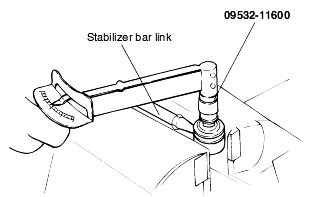
Check the bushing for wear and deterioration.
Check the lower arm for bends and other damage.
Check the ball joint dust cover for cracks. If there is a crack on the dust cover, replace the ball joint assembly.
Check the lower arm connecting bolt.
Shake the ball joint stud several times to test for looseness.
Check the lower arm ball joint rotating torque.
Standard value 1.0-3.5 Nm (10-35 kgf·cm, 0.7-2.6 lb·ft) MAX. |
Measure the lower arm ball joint rotating torque at the 0.5-2 rpm angular speed oscillating 3° at room temperature after 24 hours from completionassembly.
When the rotating torque is above the maximum standard value, replace the ball joint assembly.
When the rotating torque is less than the minimum standard value, the ball joint may be used again if there is no wear in the ball joint.

Check the stabilizer bar link ball joint for rotating starting torque.
If there is a crack on the dust cover, replace the ball joint dust cover and apply grease.
Shake the stabilizer link ball joint several times to test for looseness.
Install the self locking nut on the ball joint and measure the ball joint rotating starting torque.
Standard value 0.7-2 Nm (7-20 kg·cm, 0.52-1.5 lb·ft) |
After 24 hours from completion assembly, rotate the ball joint stud to the left and right five times.
Afterwards, measure the rotating starting torque around the range of 2 rpm at room temperature.
If the rotating starting torque is above the maximum standard value, replace the stabilizer link.
If the rotating starting torque is less than the minimum standard value and there is no ball joint abnormal wear or excessive gap, the ball jointmay be used again.
